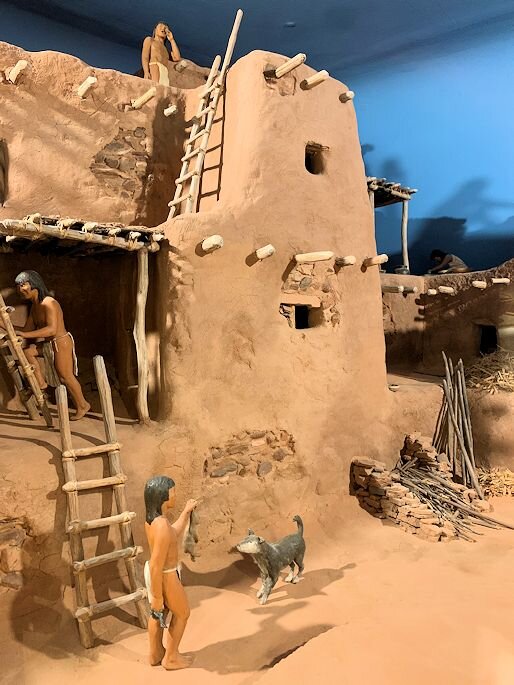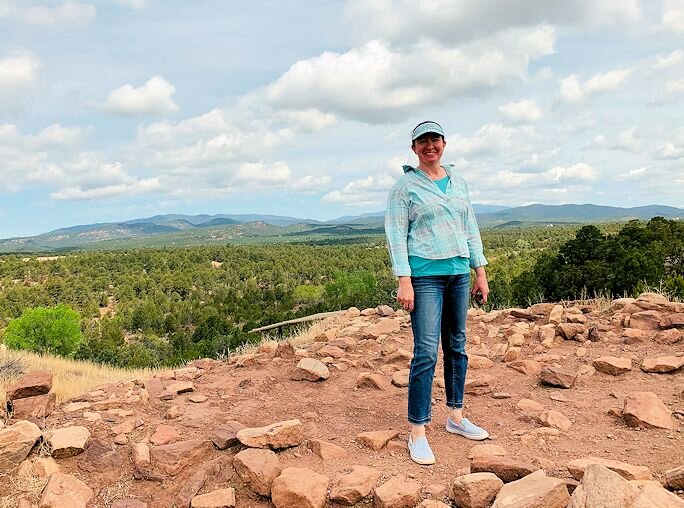
Pecos Pueblo
May 30, 2021
Hello everyone,
We've had a slight delay in getting this week's email around. Erin's been terribly busy trying to nurse the kittens along, and, unfortunately, none of them have survived. That's probably the most frustrating thing after a month's effort was put into them by Kim and Erin. We think that they were left alone too long between when the mother abandoned them and we took them in. But, that's life on the ranch, watching the constant cycle of life and death unfold. Otherwise, construction is moving right along and I'm doing new things, as well as getting better at the things that have now become standard work for me. We have a new foreman at the site and there's a different energy going on there now, which is not altogether a bad thing. Mainly, though, my nearly 45-year-old body is pretty whooped at the end of the day and it sometimes gets easy to let things like this email slide. We keep getting lots of rain and storms, in spite of our position in the high desert. All the locals tell me that this has been a very wet and cold spring by historical standards. And, I tell you what, it comes at you from all directions. Usually over Rowe Mesa from the west, but it also tracks down the Pecos River from northwest to southeast and also gets thrown at us from the east when a low sits over the Texas panhandle and we get a backdoor cold front...lots to learn with every day a new adventure! And, we have finally seen our first snake, but just a little ring snake on our front stoop who seemed to be displaced after a downpour. This week is finally turning to summer weather, though, with highs in the mid to upper 80Fs and lows in the mid to upper 50Fs, so if we're going to see any rattlers, I think it's about to be showtime!
Our biggest doings lately was our trip to Pecos Pueblo over Memorial Day weekend. What an amazing time we had! This has been a long-planned trip, originally hatched back East, but now that we are practically right next to it it's taken us almost six months to get there...but well worth the wait! The Pueblo began around the year 1100, at the time being one of about two dozen rock and mud villages in the valley. The valley itself began to be occupied as far back as 11,500 BC and archaeologists have found seven different types of ceramics in the valley from that oldest point until the historical period. Within 350 years the Pueblo had grown to about 2000 souls and, at that point, had five storey buildings with a series of porches that ran along the second and third floors, serving as upper storey passages which one could walk around the whole village on. They raised corn, beans and squash and planted them in successive waves throughout the spring to prevent unexpected frosts from killing everything, as this sits at about 7000'. They also domesticated and raised turkeys. There were also twenty ceremonial kivas at the Pueblo, like what I mentioned in the last email where the Fire of Montezuma was kept for so long. We actually got to climb ladders down into two reconstructed ones, and it was awesome! This was also the site of a historic encounter between the Spanish and these Puebloans, when in 1540 the Coronado expedition visited the Pueblo on its way to try and find Quivira, which was the fabled settlement out on the plains which was reportedly full of metal, the 'Seven Cities of Gold' legend. They eventually made it to their goal in what is now central Kansas, but it was not full of gold. The legend persisted and at one point the Spanish referred to the entire unsettled portion of the western US as Quivira. Back in Pecos they found the largest inhabited settlement in North America at the time, with the northern section of the Pueblo containing one large apartment building that was five storeys tall with 600 units and 1000s of bushels of corn dried and stored there. The Spanish returned in 1598 to settle and had their first church built by 1617 outside of town and then one closer in to town in 1625. The Indians burned this to the ground in the 1680 Pueblo Revolt, only to see a one-room church rebuilt years later when they returned, in force, to the Pueblo and then finally built the one that we got to see in 1717. A separate cluster of apartments grew around this church and became the southern section of the Pueblo that was on friendlier terms with the Spanish. Fast forward to the 1800s and you have the last inhabitants leaving less than a decade before the US Dragoons marched through on their way to taking Santa Fe, which ended up being a bloodless takeover, the first foreign capital that the US ever took. Sometimes you see the name Cicuye for this Pueblo, but nobody can agree as to its meaning or etymology...a Towa-speaking people but introduced to the Spanish originally by Keresan-speaking guides. Some of the many possible meanings of the name Pecos are: Place above the Water; Place where there is Water; Place down where the Stone is on Top; or the outlier, Village of 500 Warriors. If you are ever out this way, this is a must-see!
Finally, our weekly batch of pictures: three landscape pictures showing plants and their blossoms and tendrils that are surging now; and the rest all from Pecos Pueblo. The Pueblo pictures are of: the cool diorama in the museum showing what the apartments would have looked like with their balconies; then a shot of Erin with the high peaks between us and Santa Fe behind her; then a shot of her in the kiva, plus two of the ladder entrance to it; next are three black & whites, one of the entrance to a kiva, then two shots of the church; then two color shots of the church; then one of the walls that encircled the town(traders had to camp outside of these); and then finally one of the last living Pecos Indians who was actually born at the Pueblo, before moving with the rest of his people to Jemez Pueblo...wow!
That's about it, guys. Expect the next email right behind this one as I try to get things caught back up...have a good one!

Cactus Blossoms

New Cholla Growth

Yucca Flowers

Pecos Pueblo Diorama I

Pecos Pueblo Diorama II

Erin @ 7000'

Kiva Erin

Kiva Interior

KIva Sky

Kiva Top

Our Lady of the Angels of Porciuncula I

Our Lady of the Angels of Porciuncula II

Our Lady of the Angels of Porciuncula III

Our Lady of the Angels of Porciuncula IIII

Town Wall

Wahu Toya